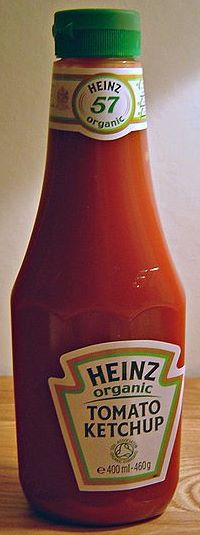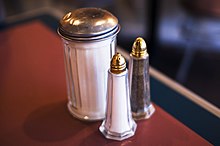Condiment: Difference between revisions
Pickles in and of themselves are not a condiment. They may take the form of a condiment, such as relish, but are not a condiment by default |
No edit summary |
||
| Line 2: | Line 2: | ||
[[Image:Salt, sugar and pepper shakers.jpg|thumb|Salt, sugar, and ground black pepper corns are commonly available on Western restaurant tables; however, they are not always considered to be condiments.]] |
[[Image:Salt, sugar and pepper shakers.jpg|thumb|Salt, sugar, and ground black pepper corns are commonly available on Western restaurant tables; however, they are not always considered to be condiments.]] |
||
A '''condiment''' is a prepared edible [[Chemical substance|substance]] or [[mixture]], often [[Food preservation|preserved]] or [[Fermentation (food)|fermented]] (usually a liquid), that is added in relatively small quantities, most often at the table, to make food more suitable to the diner's taste.<ref>{{cite book |last=McGee |first=Harold |authorlink=Harold McGee|title=On Food and Cooking |year=2004 |publisher=Scribner |location=New York |isbn=0-684-80001-2}}</ref> Condiments may be dry, such as a mixture of [[seasoned salt|herbs and seasonings]] or [[Parmesan cheese]], or preserved [[sauce]]s served from a bottle, jar, or other container - such as |
A '''condiment''' is a prepared edible [[Chemical substance|substance]] or [[mixture]], often [[Food preservation|preserved]] or [[Fermentation (food)|fermented]] (usually a liquid), that is added in relatively small quantities, most often at the table, to make food more suitable to the diner's taste.<ref>{{cite book |last=McGee |first=Harold |authorlink=Harold McGee|title=On Food and Cooking |year=2004 |publisher=Scribner |location=New York |isbn=0-684-80001-2}}</ref> Condiments may be dry, such as a mixture of [[seasoned salt|herbs and seasonings]] or [[Parmesan cheese]], or preserved [[sauce]]s served from a bottle, jar, or other container - such as relish, salsa, hummus, pineapple cheese dip, or a piece of a food, such as a [[lime]] segment used on [[pork chops]]. Some condiments are packaged in single-serving [[sachet]]s, particularly to be supplied with [[take-out]] and [[fast food]]s. |
||
Condiments are sometimes added prior to serving, for example a sandwich made with [[ketchup]] or [[mustard (condiment)|mustard]]. Some condiments are used during cooking to add flavor or texture to the food; for example, [[barbecue sauce]], [[teriyaki sauce]], and [[soy sauce]] all have flavors that can enhance the tastes of a variety of different meats and vegetables. |
Condiments are sometimes added prior to serving, for example a sandwich made with [[ketchup]] or [[mustard (condiment)|mustard]]. Some condiments are used during cooking to add flavor or texture to the food; for example, [[barbecue sauce]], [[teriyaki sauce]], and [[soy sauce]] all have flavors that can enhance the tastes of a variety of different meats and vegetables. |
||
Revision as of 14:41, 14 January 2009


A condiment is a prepared edible substance or mixture, often preserved or fermented (usually a liquid), that is added in relatively small quantities, most often at the table, to make food more suitable to the diner's taste.[1] Condiments may be dry, such as a mixture of herbs and seasonings or Parmesan cheese, or preserved sauces served from a bottle, jar, or other container - such as relish, salsa, hummus, pineapple cheese dip, or a piece of a food, such as a lime segment used on pork chops. Some condiments are packaged in single-serving sachets, particularly to be supplied with take-out and fast foods.
Condiments are sometimes added prior to serving, for example a sandwich made with ketchup or mustard. Some condiments are used during cooking to add flavor or texture to the food; for example, barbecue sauce, teriyaki sauce, and soy sauce all have flavors that can enhance the tastes of a variety of different meats and vegetables.
Pickles are not a condiment.
There is some overlap between condiments and seasonings.
Condiment gallery
-
Salsa verde, salsa roja
-
Dijon mustard
-
Packets of duck sauce
-
American Steak sauce
-
British Brown sauce
-
Sriracha chili sauces
-
Grated American parmesan cheese
-
A tube of prepared wasabi
See also
References
- ^ McGee, Harold (2004). On Food and Cooking. New York: Scribner. ISBN 0-684-80001-2.






